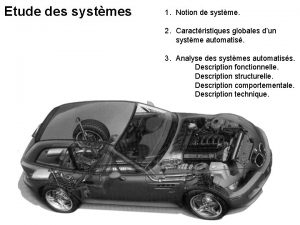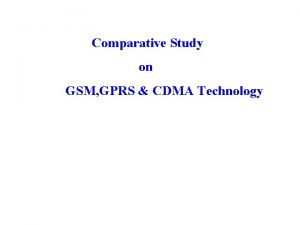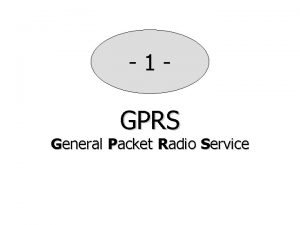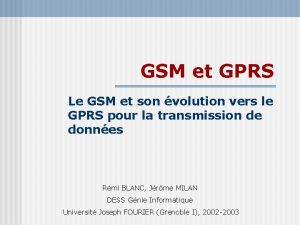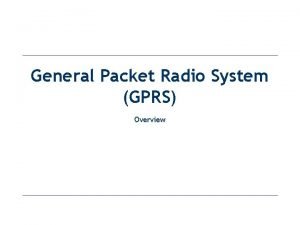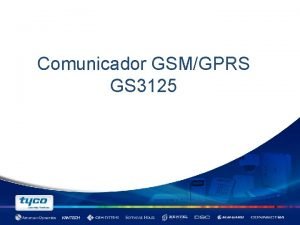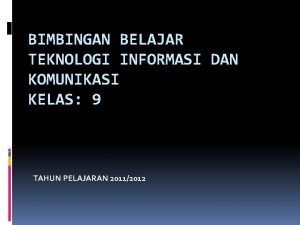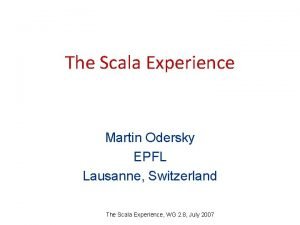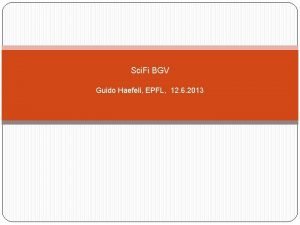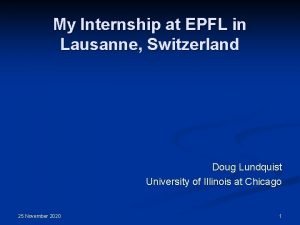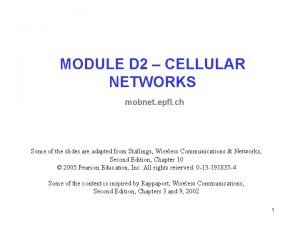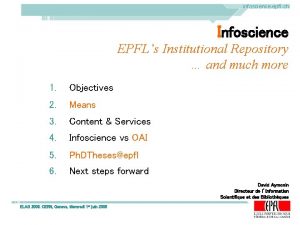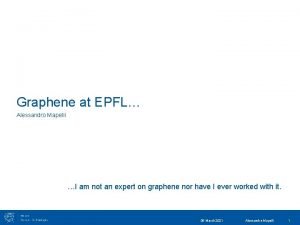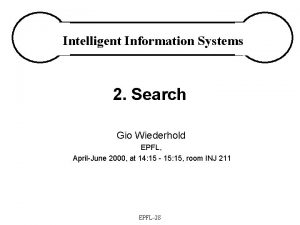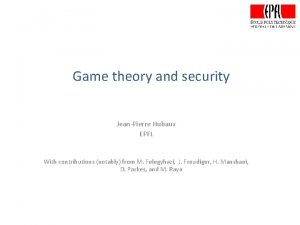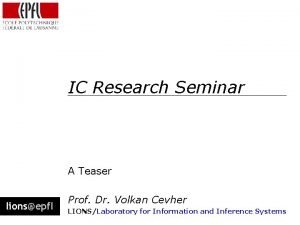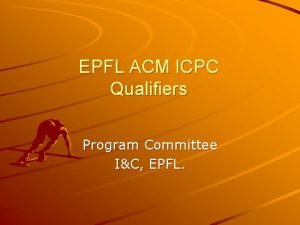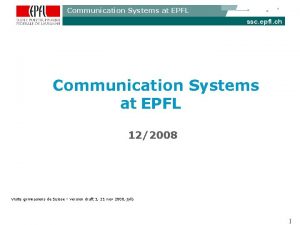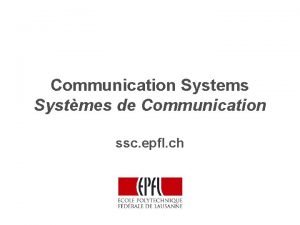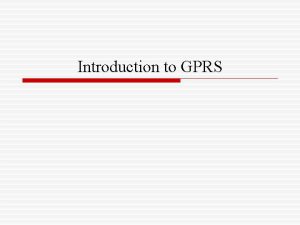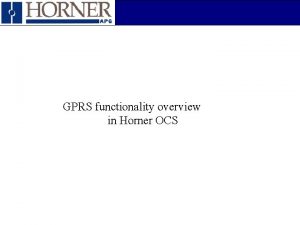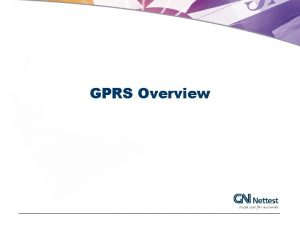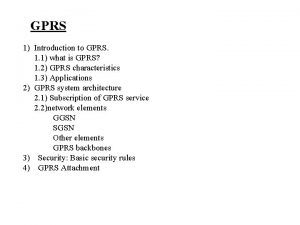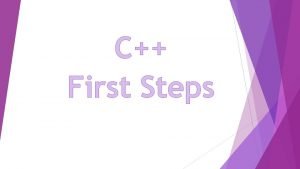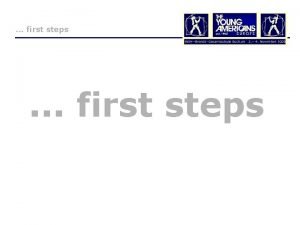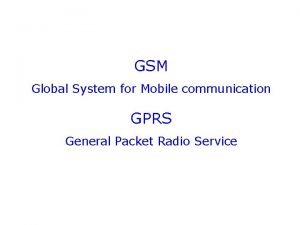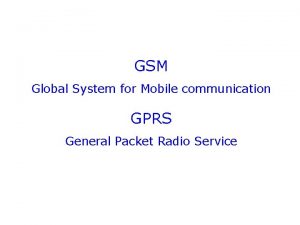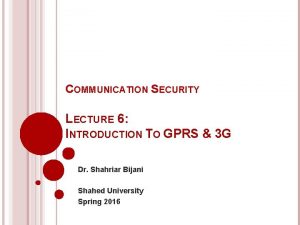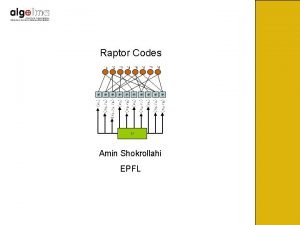EPFL Section Systmes de Communication GPRS First steps































- Slides: 31

EPFL Section Systèmes de Communication GPRS « First steps toward Wireless data » Frédéric Michaud Network Development Engineering 27/01/2004 June 2002 V 1. 0 Page 1

GPRS Part 1 Content From Theory… INTRODUCTION ARCHITECTURE MOBILITY MANAGEMENT SESSION MANAGEMENT RADIO RESOURCE MANAGEMENT January 2004 F. Michaud – GPRS course 2

Introduction General Packet Radio Service: n a way to extend packet transfer up to the mobile station GSM – Circuit Switch architecture – Indirect access to IP network – Too sensitive connection for data (today) – January 2004 GPRS Expensive solution for data network (HSCSD) F. Michaud – GPRS course – Packet Switch architecture – End to End IP service (mobile = IP host) – Re-use BSS architecture – New core architecture – Max theoretical rates ~170 kbps 3

Architecture Network Diagram NSS HLR MSC/VLR GPRS Core Network Gc Gr Gs Gi SGSN Gn Gn Transcoder Ater Charging Gateway Um Abis Gn Border Gateway Gp Inter PLMN Backbone BTS January 2004 Gn GPRS IP Backbone Gb BSC GGSN DNS A BSS ISP - External Network F. Michaud – GPRS course 4

Architecture evolution of BSS network New hardware in BSS: Packet Controlling Unit (PCU) n • can be compared to TRAU function in GSM • generally located in the BSC • heart of the packet transmission in BSS network • allow the dynamic traffic allocation BTS • Provide the radio resource management mechanism, adapted to transfer RLpacket C RLC PCU SGSN buffer RLC RLC LLC LLC buffer RLC RLC buffer Gb Abis January 2004 F. Michaud – GPRS course 5

Architecture New core equipments HLR VLR Charging Gateway External IP world PCU GGSN IP network PCU SGSN • Packet routing (IP – BSS) • Mobility Management • Session Management • Charging • Cyphering and compression n GGSN • GPRS Tunneling (PLMN – internet) • Charging • O&M (Operation & Maintenance) • Lawful interception Other equipment: § Border Gateway, Charging Gateway, DNS, Firewalls January 2004 F. Michaud – GPRS course 6

Mobile equipment Three types of Mobile Classes n CLASS A: « Rolls Royce » CS Core Network (GSM) Simultaneous CS/PS Paging Simultaneous CS/PS data transfer PS Core Network (GPRS) n CLASS B: « Standard » CS Core Network (GSM) Simultaneous CS/PS Paging CS call or PS data transfer PS Core Network (GPRS) n CLASS C: « Cheap » CS Core Network (GSM) CS mode (GSM only) or PS mode (GPRS only) PS Core Network (GPRS) January 2004 F. Michaud – GPRS course 7

Mobility Management Mobile States n IDLE – not attached to GPRS – MS is not reachable IDLE GPRS Attach STANBY timer expiry GPRS Detach n READY timer expiry Force to STANBY – MS known down to Cell by SGSN – May receive/transmit packets – No Packet paging required – MS remains in READY state until “READY Timer” expires or GPRS Detach PDU Transmission STANDBY n January 2004 READY STANDBY – MS known down to Routing Area by SGSN – MS attached to GPRS – May receive Packet paging – No data reception or transmission F. Michaud – GPRS course 8

Mobility Management GPRS Attach 3 5 2 4 1 2 6 7 1. GPRS Attach Request 2. Authentication 3. Update Location (GPRS) 4. Insert Subscriber Data 5. Location Update (GSM) 6. GPRS Attach Accept 7. Attach complete January 2004 F. Michaud – GPRS course 9

Mobility Management Routing Area Update 5 4 3 2 1 8 6 7 1. RA Update Request (old RAI) 2. DNS Query: IP @ for old RAI 3. SGSN Context Request 4. SGSN Context Response 5. Forward Packets 6. Update PDP Context Request: IP @ of new RAI 7. Update PDP Context Response 8. RA Update Accept January 2004 F. Michaud – GPRS course 10

Session Management Notion of Qo. S n Qo. S = Quality of Service n 5 Classes as specified in ETSI • Service Precedence / Priority • Delay • Mean Throughput • Peak Througput • Reliability n FTP (NRT): n Video Streaming (RT): – Service: minor – Service: medium – Delay: < 7 sec (most likely Best effort) – Mean throughput: 4. 4 kbps – Mean throughput: 44 kbps – Peak throughput: N/A – Peak throughput: 64 kbps – Reliability: high to medium redundancy – Reliability: medium to low (UDP protocol) January 2004 F. Michaud – GPRS course 11

Session Management Notion of PDP context n n Packet Data Protocol context: – set of information stored in mobile, SGSN and GGSN – allow packet data transfer between a certain type of network and the mobile PDP context contains: January 2004 Main Field Description type of PDP network IP, X 25 …. Mobile address IP address or X. 121 address for X 25 network SGSN address IP address of the serving SGSN NSAPI Network Service Access Point Qo. S Profile Quality of service negociated for this PDP context Access Point Name APN (service) requested by the mobile (ie WAP, internet…) F. Michaud – GPRS course 12

Session Management PDP Context Activation 1 2 5 3 1. Activate PDP Context Req 2. DNS Query 3. Create PDP Context Req 4. Create PDP Context Rsp 5. Activate PDP Context Ack January 2004 4 F. Michaud – GPRS course 13

Session Management Data Transfer SNDCP IP S-CDR IP GTP G-CDR IP IP@ src IP@ dst Mobile SGSN Server GGSN January 2004 F. Michaud – GPRS course 14

Radio Resource Management Notion of GPRS territory TRX 1 TRX 2 CCCH TCH TCH GSM Territory GPRS Territory TCH Default GPRS Capacity Dedicated GPRS Capacity Territory border move based On GSM and GPRS traffic load evolution January 2004 F. Michaud – GPRS course 15

Radio Resource Management Physical Layer TDMA frame=4, 615 ms 01 2 3 4 5 6 7 1 GPRS multiframe = 52 TDMA frame=240 ms Block 0 Block 1 Block 2 T Block 3 Block 4 Block 5 i Block 6 Block 7 Block 8 i Block 9 Block 10 Block 11 i 0 4 8 13 17 21 26 30 34 39 43 47 51 12 blocks of 4 radio burst each Each block can transfer one GPRS logical channel information January 2004 F. Michaud – GPRS course 16

Radio Resource Management Logical Signalling for GPRS January 2004 F. Michaud – GPRS course 17

Radio Resource Management Timeslot sharing n GPRS data transfer = discontinuous series of Temporary Block Flows. – 1 TBF = 1 user (with a given TFI, TLLI, USF) – 1 TBF can be transferred onto several radio timeslots TBF 4 TBF 3 TBF 2 TBF 3 TBF 1 TSL 0 TSL 1 TSL 2 TSL 3 TSL 4 TSL 5 TSL 6 TSL 7 BCCH TCH TCH PDCH TDMA frame n Data transfer = Uplink / Downlink TBF (Temporary Block Flow) Assignment – Timeslots allocation GSM CCCH channels (RACH - AGCH - PCH) (GPRS - phase 1) – GPRS phase 2: dedicated common control channels (PBCCH/PCCCH) January 2004 F. Michaud – GPRS course 18

GPRS Part 2 Content … to practice IMPLEMENTATION CONSTRAINTS NETWORK DIMENSIONING NETWORK PLANNING ANALYSIS AND OPTIMISATION TOOLS FOR GPRS January 2004 F. Michaud – GPRS course 19

Implementation Constraints Upgrade of GSM network n New Core Network – GPRS backbone is an IP network • New approach in Mobile Telecommunication • First interaction between IT and mobile telecom network dept. n Multi-supplier solution – Interoperability problems • Interface Gb, Gs, Gr are standardised by ETSI but… ú Immature specification leads to uncompatibility ú Gb interface is very sensible • Mobile / network compatibility over air interface ú January 2004 PBCCH problem F. Michaud – GPRS course 20

Implementation Constraints Software Releases n Release compatibility – – n n Network is often heterogeneous ú Different generation of base stations ú Different switch and BSC Release are delivered at different times Incomplete GPRS features – Qo. S not implemented in first release – PBCCH not implemented in first release immature ETSI specifications – January 2004 Suppliers follow different versions F. Michaud – GPRS course 21

Implementation Constraints Heterogeneous BSS Network GPRS Core Network South region - BSS Network Supplier A North region - BSS Network Supplier B GPRS handset n Problem of uniform Quality of Service (different SW/HW, different problems) n Complex network evolution (i. e. new feature cannot be implemented country wide) January 2004 F. Michaud – GPRS course 22

Implementation Constraints Handsets & Services n Limitation in mutlislot & coding scheme capability: • First handsets: 2+1 (i. e. 2 TSL DL / 1 TSL UL) Ø 24 kbps DL / 12 kbps UL • Current handsets: 4+1 Ø n 48 kbps DL / 12 kbps UL ETSI specifications problems • Lots of change request • PBCCH not supported by network and first GPRS mobiles n Poor content for GPRS Services • Lack of «adapted» phones • Lack of «killer» applications January 2004 F. Michaud – GPRS course 23

GPRS Dimensioning Number of GPRS users Paquet transfer per users Quality of Service Coverage area Peak hours Network Dimensioning Transmission capacity (Abis/Gb) Bearer size Number of PCU Radio Dimensioning GPRS Territory size Number of cells TRX upgrade Signalling increase New hardware requirements January 2004 F. Michaud – GPRS course 24

Analysis and optimisation n Traffic analysis January 2004 F. Michaud – GPRS course 26

Analysis and optimisation n Performance Analysis – Access to Network resource 1123 32. 15% 298 81. 88% 57. 26% January 2004 F. Michaud – GPRS course 27

Analysis and optimisation n Performance Analysis – Session success 13 % 2446 45. 4% 623 87% 53. 3 % January 2004 F. Michaud – GPRS course 28

Analysis and optimisation Tools for GPRS n Probe System l Data capture across all GPRS network interfaces MSC VLR Gs HLR Gr Gc Gi BTS BSC Gb SGSN internet Gn Gp GGSN BG Foreign PLNM 1. Data capture 2. Data data storage January 2004 F. Michaud – GPRS course 3. Data analysis 29

Analysis and optimisation Tools for GPRS n Protocol analyser l January 2004 In depth signalling study F. Michaud – GPRS course 30

Documentation n Réseaux GSM (ISBN 2 -7462 -0153 -4) Ø n Ingénierie des réseaux cellulaires (ISBN 2 -7462 -0550 -5) Ø n Peter Stuckmann GPRS Signalling & Protocol Analysis – Vol. 1 Ø January 2004 Sami Tabbane The GSM Evolution - Mobile Packet Data Services (ISBN 0 -470 -84855 -3) Ø n Xavier Lagrange, Philippe Godlewski, Sami Tabbane Gunnar Heine F. Michaud – GPRS course 31

That’s all Folks! January 2004 F. Michaud – GPRS course 32
 Structure d'un système technique
Structure d'un système technique Delrin 2700 nc010 properties
Delrin 2700 nc010 properties Systmes
Systmes Gprs stands for
Gprs stands for Private apn architecture
Private apn architecture Gprs cdma
Gprs cdma Gprs
Gprs Architecture gprs
Architecture gprs Gsm protocol
Gsm protocol Gs3125 software download
Gs3125 software download Kepanjangan dari gprs adalah.... *
Kepanjangan dari gprs adalah.... * Gprs stands for
Gprs stands for Gprs architecture
Gprs architecture Sgsn stands for
Sgsn stands for Industrial automation epfl
Industrial automation epfl Scala lausanne
Scala lausanne Lphe epfl
Lphe epfl Epfl internship
Epfl internship Moodle epfl
Moodle epfl Mobile networks epfl
Mobile networks epfl Infoscience epfl
Infoscience epfl Leslie camilleri
Leslie camilleri Epfl library
Epfl library Epfl cmi
Epfl cmi Intelligent agents epfl
Intelligent agents epfl Game theory epfl
Game theory epfl Epfl map
Epfl map Point velo epfl
Point velo epfl Lions epfl
Lions epfl Ic epfl
Ic epfl It is also called axial movements
It is also called axial movements First steps in english linguistics chapter 8
First steps in english linguistics chapter 8
